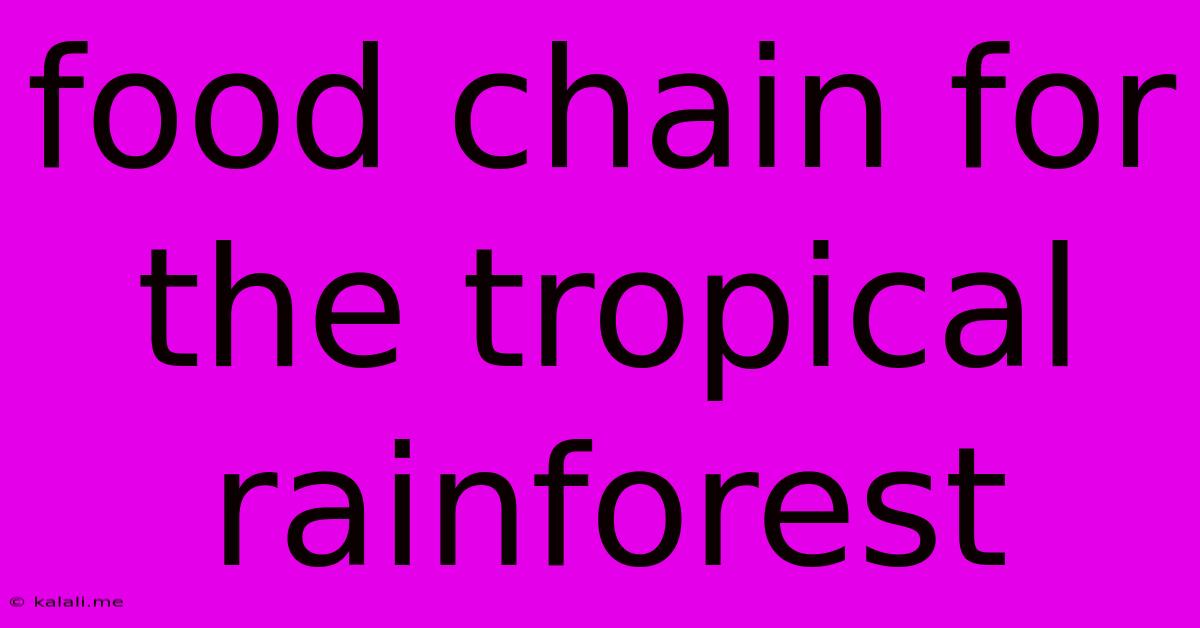Food Chain For The Tropical Rainforest
Kalali
May 09, 2025 · 3 min read

Table of Contents
The Intricate Web: Understanding the Tropical Rainforest Food Chain
The tropical rainforest, a vibrant tapestry of life, boasts one of the most complex and diverse food chains on Earth. This intricate network, far from being a simple linear progression, is a multifaceted web of interactions between producers, consumers, and decomposers. Understanding this dynamic system is crucial to appreciating the delicate balance of this vital ecosystem. This article explores the various trophic levels and the key players within the tropical rainforest food chain.
Producers: The Foundation of Life
At the base of the rainforest food chain are the producers, primarily plants. These photosynthetic organisms, including towering trees like mahogany and emergent giants, smaller shrubs, epiphytes clinging to branches, and a vast array of herbaceous plants on the forest floor, convert sunlight into energy through photosynthesis. This energy is the foundational fuel for the entire ecosystem. The incredible biodiversity of rainforest plants provides a rich and varied food source for the consumers higher up the chain. This includes a wide range of fruiting plants, providing sustenance for a myriad of animals, and leaf-litter that forms the basis of the decomposer food web.
Consumers: A Hierarchy of Eaters
Consumers are organisms that obtain their energy by consuming other organisms. The rainforest food chain is characterized by a complex hierarchy of consumers:
-
Primary Consumers (Herbivores): These animals feed directly on the producers. This group includes a wide array of insects like leafcutter ants and butterflies, as well as larger animals like sloths, monkeys, and various species of rodents. The abundance and diversity of primary consumers are directly linked to the productivity of the rainforest's plant life. They play a critical role in nutrient cycling and energy transfer.
-
Secondary Consumers (Carnivores and Omnivores): Secondary consumers prey on primary consumers. This group is incredibly diverse, ranging from small lizards and frogs to larger predators like snakes, jaguars, and birds of prey. Many animals occupy multiple trophic levels, acting as both secondary and tertiary consumers depending on their diet. For example, a monkey might eat insects one day and fruit the next. This complex dietary flexibility plays a significant role in maintaining ecosystem stability.
-
Tertiary Consumers (Apex Predators): At the top of the food chain are the apex predators. These animals have few or no natural predators, and their presence significantly impacts the populations of other species. In the rainforest, this includes animals like jaguars, harpy eagles, and anaconda snakes. These apex predators help to regulate populations and maintain the balance of the ecosystem.
Decomposers: The Recycling Crew
The final crucial component of the rainforest food chain is the decomposers. These organisms, including bacteria, fungi, and invertebrates such as termites and millipedes, break down dead organic matter – leaves, dead animals, and waste products – releasing nutrients back into the soil. This process is essential for nutrient cycling and allows the producers to continue thriving. Without decomposers, the rainforest would quickly become choked with dead organic matter, hindering the growth of new plants and ultimately impacting the entire food web.
The Interconnectedness of It All
The tropical rainforest food chain is far from a simple linear progression. It is a complex web of interconnected relationships, with many organisms occupying multiple trophic levels and playing multiple roles in the ecosystem. The removal or significant decline of even one species can have cascading effects throughout the entire food web, highlighting the importance of conservation efforts to protect this incredibly diverse and delicate ecosystem. Understanding this intricate network is essential for appreciating the beauty and fragility of the tropical rainforest and underscores the need for responsible stewardship of this invaluable natural resource.
Latest Posts
Latest Posts
-
How Many Hours Is 123 Minutes
May 09, 2025
-
How Many Cups In 52 Oz
May 09, 2025
-
What Are The Factors Of 79
May 09, 2025
-
Convert 94 Degrees Farenheit To Celcius
May 09, 2025
-
111 Minutes Is How Many Hours
May 09, 2025
Related Post
Thank you for visiting our website which covers about Food Chain For The Tropical Rainforest . We hope the information provided has been useful to you. Feel free to contact us if you have any questions or need further assistance. See you next time and don't miss to bookmark.